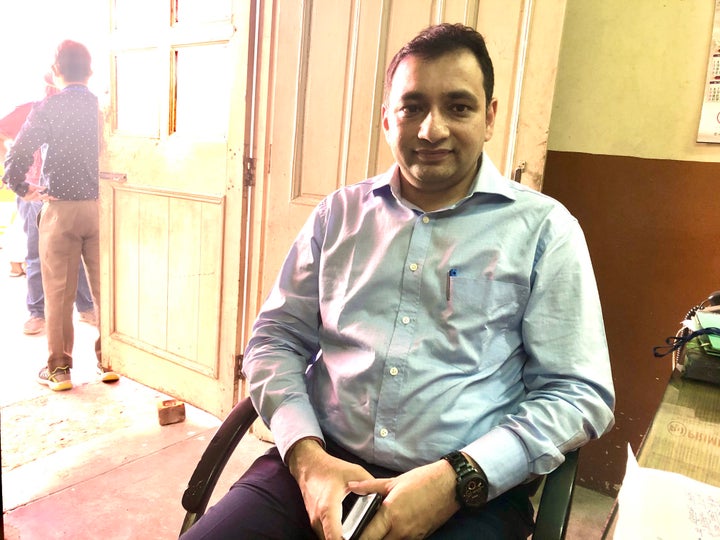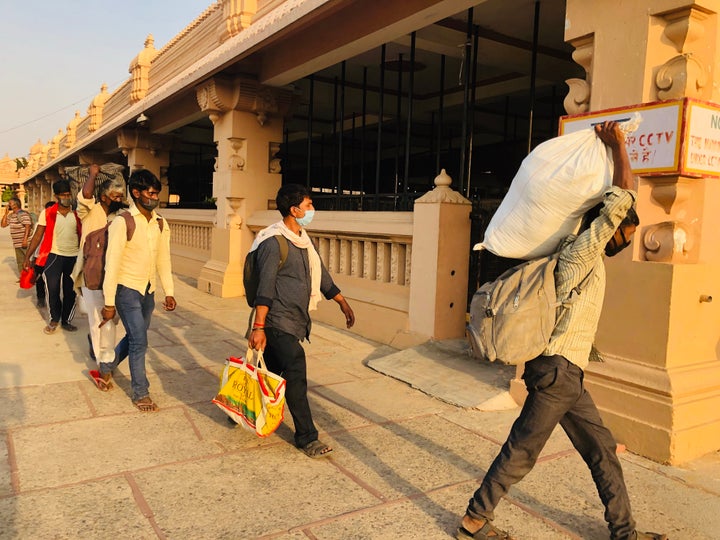
NEW DELHI — Additional District Magistrate Arun Gupta spent a hot summer afternoon supervising the movement of 12 buses from the medical screening centre at Chhatarpur to another one at the Delhi Institute of Pharmaceutical Sciences and Research where migrant workers were waiting to be ferried to trains bound for Uttar Pradesh.
Gupta, while speaking on his mobile phone, repeated over and over again that the buses had to return to Chhatarpur in time to ferry the migrant workers from Delhi to Bihar, later that night.
The 40-year-old officer is in charge of three centres in South Delhi, one of 11 districts in the national capital, where migrant workers stranded because the two-month long coronavirus lockdown are medically screened and sent to board trains to their home states.
Outside Gupta’s temporary office inside the large Chhatarpur rest house, a queue of Bihar-bound migrant workers waiting to be screened grew longer and restive. Thousands more waited their turn in the enormous hall of the sandstone temple next door.
Gupta says that his team often works for 14 hours a day, staying put until the last train for the day leaves, but the numbers of migrant workers showing up at the centres keeps increasing.
“It is a hectic and long process involving a lot of human resources. For the last one week, one-third of the district administration is involved in this,” Gupta said in a conversation with HuffPost India on Monday.
“Every day, we have to tell people that your train has gone and there is no other train for the day, but they don’t move. They think some other train might come. This is also the truth. People are desperate,” he said.
The Prime Minister Narendra Modi-led central government together with state governments run by different political parties have let down millions of migrant workers who have been forced to walk hundreds of kilometres to reach their villages in the middle of the coronavirus lockdown. Over 100 workers have been killed in road accidents, and hundreds more have been injured.
Almost a month after the Modi government announced that special trains would ferry them home free of charge, the Indian Railways claims to have operated 1,600 trains and transported 21.5 lakh workers home. But migrant workers are still walking. How and when to board one of these trains continues to elude many workers. Others say they ended up paying private persons acting as facilitators for their tickets.
The process involves either registering online with their state governments or showing up at one of the centres like the one set up in the Chhatarpur rest house that Gupta supervises. But migrant workers like 40-year-old Rani Prajapati, who cannot read or write, online registration is hard. Even getting to a medical screening centre was challenging. Some walked. Others paid their remaining money to auto rickshaw drivers who charge double or triple the regular fare. Those who cannot board a train could end up sleeping on the road.
The day that HuffPost India spoke with Gupta, the ADM said that all eleven districts in Delhi had exclusive trains ferrying migrant workers to UP, each with a capacity of 1,200 to 1,500. There were also two trains leaving for Bihar and Madhya Pradesh later that night.
In the ten days since the three testing centres were set up in South Delhi, Gupta on Monday estimated that 3,000 to 4,000 migrant workers had left for Bihar from the district, 2,500 to 3,000 for UP, and 1,000 for Madhya Pradesh, from this district.
The Ministry of Railways, Gupta explained, gives the train schedule to the district administration the evening before next day’s departures, and the quota of tickets for each district is provided only hours before the trains leave.
Gupta says his team has to identify the migrant workers who can leave that day, sort them out by the destination station, prepare a list with details like their mobile phone numbers and Aadhar card numbers, organise a medical screening, and put them on buses that take them to the railway station. For those who are left behind, they organise food and a place to stay.
Gupta on Monday said that it could take another two weeks before the bulk of migrant workers were sent home.
“Every day, we have to tell people that your train has gone and there is no other train for the day, but they don’t move.”
Media criticism
The Delhi government official says it isn’t always easy watching the Indian media’s coverage of the migrant tragedy and hearing its unvarnished criticism of the authorities.
“Sometimes, it is demotivating when we see the media projecting only one picture when we are trying our best,” he said. “But the media is also not wrong. We can see that we can only send them in a phased manner. There are so many people who are waiting. They are facing problems while waiting. They don’t have cash and many of them are homeless.”
On how it felt to watch the news filled with images of the migrant workers walking on the roads, Gupta said, “Media criticism always puts pressure on the government to work with more energy and more resources. That is necessary because if we all get complacent then it won’t be good. Complacency is not good.”
“Sometimes, it is demotivating when we see the media projecting one picture only when we are trying our best.”

‘Not taken a break’
Before he started supervising the work to get migrant workers on trains, Gupta said that he was involved in different aspects of administrative work from requisitioning officers to combat the coronavirus outbreak to distributing food at 125 centres in his district.
“I have not taken a break for a single day since 11 March,” he said. “This has been really exhausting. There were days when I went home at 1 am.”
But Gupta was uncritical of the unpreparedness that forced India into a punitive lockdown that hurt its poorest and most vulnerable citizens. The ADM said the situation had worsened quickly and there was no choice but to impose a complete lockdown in order to stop the deadly virus from spreading to the hinterlands.
“Till Holi, the situation was not very bad. We were doing awareness and sanitation activities. Then, in a span of just one week, things got worse. The lockdown was sudden and it wasn’t clear for how long,” he said. “At the time, a complete lockdown was necessary.”
The response of the authorities was also weakened by the fact that the coronavirus had a uniformly crippling effect, with no state government in the position to help the other, Gupta said. “No one is in the situation to help the other. All are entangled. This is a peculiar situation,” he said.
The Uttar Pradesh government has said that returning migrant workers is leading to a rise in coronavirus cases. On Thursday, the state government said that of the 5,175 cases in the state, 1,041 were migrant workers who had tested positive for COVID-19, and over 5.42 lakh were under surveillance.
Gupta, who lives in Delhi with his wife, hails from Lucknow. He studied physics and maths at Lucknow University. Before joining the civil service, Gupta taught history at Delhi University. He was earlier posted in the Andaman and Nicobar Islands.
In addition to the social recognition and the desire to serve the country, Gupta said the civil service allowed officers to do a vast array of work and made a lot of resources available to them by virtue of being in the service.
“This has been really exhausting. There were days when I went home at 1 am.”

‘Sense of pride’
Even as he works long hours and through weekends, while Delhi and state governments all over the country belatedly pick up the pace in managing the migrant workers crisis, Gupta said that he can’t help feeling a “sense of pride” in having been part of India’s efforts to combat the global pandemic.
The Delhi administration, Gupta said, had managed hospitals and quarantines, distributed food, facilitated the movement and delivery of essential items and services, issued travel passes and controlled cross border movement.
“There is a sense of pride that at a time of national and international disaster, we are working in the administration that is looking after all the works required for the country and society,” he said.
For the latest news and more, follow HuffPost India on Twitter, Facebook, and subscribe to our newsletter.